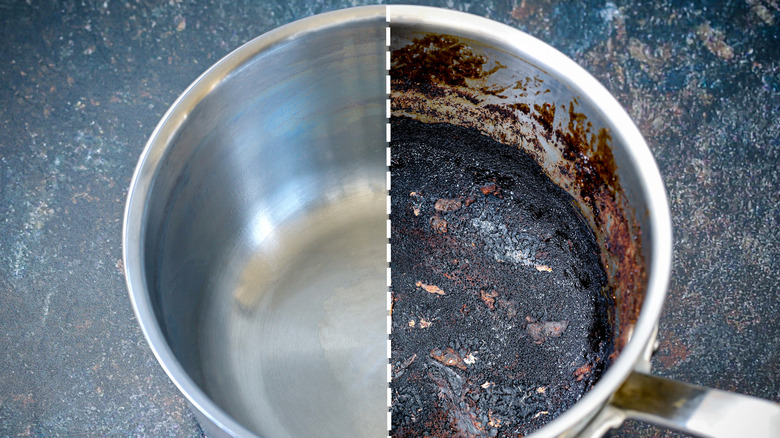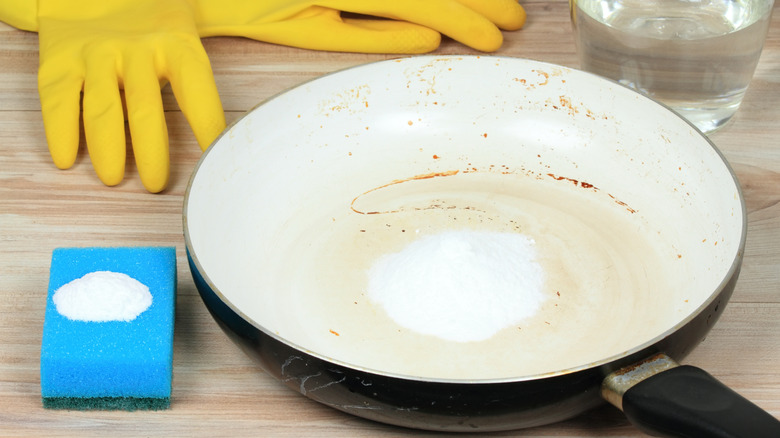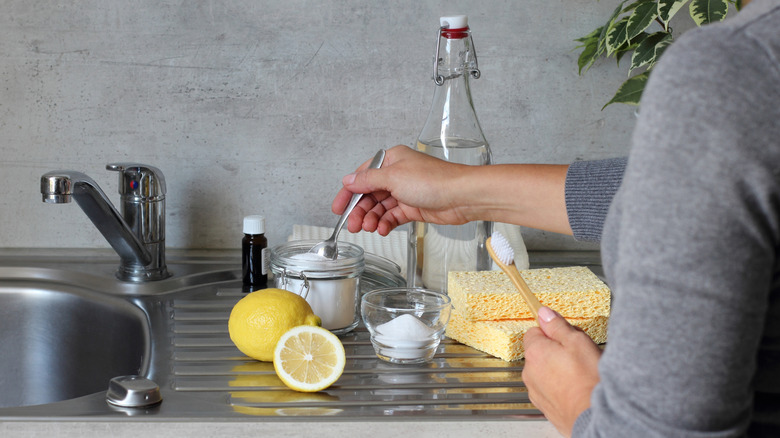Easily Revive Burnt Pots & Pans With A Common Household Item
Whether you accidentally turned up the heat too high or simply lost track of time while cooking, pots and pans can quickly burn on the stove, leaving behind unpleasant scorch marks. Instead of reaching for a store-bought cleaner or scrubbing for hours with dish soap to remove the burns, try an easier solution: baking soda, also known as sodium bicarbonate. Gentle and easy to make and use, this simple baking soda and water paste will remove burnt or baked-on bits off your favorite pans in no time.
These marks don't just make your pots and pans look messy, they may also degrade their performance. Left unchecked, your cookware's charred residue can affect the pan's ability to evenly heat and cook. It can also flake off into the pan and often alters the flavor of your food. The food may also stick to the pan more frequently, which can make your cleaning process time-consuming and frustrating. In addition, in the case of non-stick cookware, the smoldered area could potentially damage the coating. Safe to use on both stainless steel and non-stick cookware, this paste will get the job done. It's a budget-friendly and timeless natural cleaning ingredient, plus you likely already have a box of sodium bicarbonate in your cabinet. With a little elbow grease and water, you can blast away all of the burned spots for a shiny pan that's ready for your next meal.
Using baking soda to clean burnt pots and pans
Before attempting this trick, check with your cookware's manufacturer for any cleaning ingredient warnings and directions. Wash and wipe your singed cookware with a soft cloth to remove any food debris before using baking soda to clean it. Next, mix 3 parts baking soda with 1 part water in the pot, stirring into a paste. You're going to boil this, so you'll need more water, up to ½ cup for a better consistency. Bring to a boil, then remove from the heat immediately. After it cools and is safe to touch, scrub gently with a new scour pad or sponge, letting the abrasive crystals wear down the burnt residue.
This baking soda cleaning hack works by sloughing off the cookware's scorched areas through a clever chemical reaction. This natural cleaner is an alkaline base. When it comes into contact with an acidic ingredient, such as the blackened remains of last night's fajitas, it aids with breaking them down. The heat helps loosen and lift the residue more easily, saving you from a marathon scrubbing session. All the while, it's gentle enough not to scratch the surface. This dynamic duo is powerful enough to handle burnt messes in your cookware, and with one simple addition, it can be even more effective for steel pots and pans.
Using lemon, baking soda, and water to clean stainless steel pans
If you're dealing with burned grime on your stainless steel or copper pans, adding a lemon to the baking soda and water combination will boost the cleaning power. With a thin layer of water in your pan, coat it with baking soda, then stir until blended well. Cut a lemon in half, then use the interior (flesh) side of the lemon, rubbing it into the paste. You'll see a chemical reaction almost immediately as the citric acid in the lemon reacts with the alkaline baking soda. This creates fizzy bubbles with a release of carbon dioxide, giving your paste an extra edge for thorough residue removal. After the fizzing ceases, scrub the pan, remove the burnt bits, then rinse and dry.
Avoid using lemon to scrub your cast iron or non-stick pans, as the acid may damage the coating. If you're unsure if you can use it on a non-stainless steel pan, don't use it, or you risk ruining the surface. Once you're done with this easy hack, don't toss the other half of your fruit. You can use a lemon slice to clean your kitchen in a variety of ways, while leaving behind a fresh, lemony scent. It's nature's deodorizer and degreaser in one!


